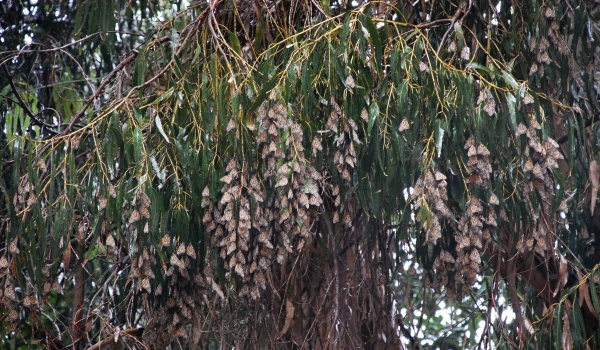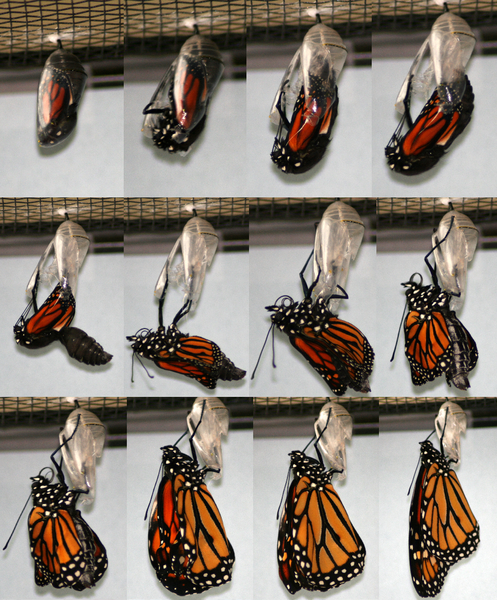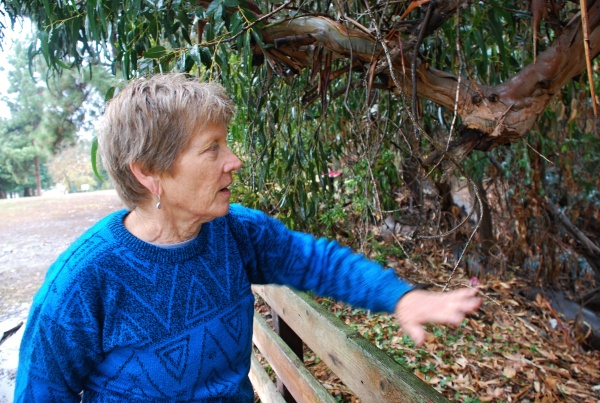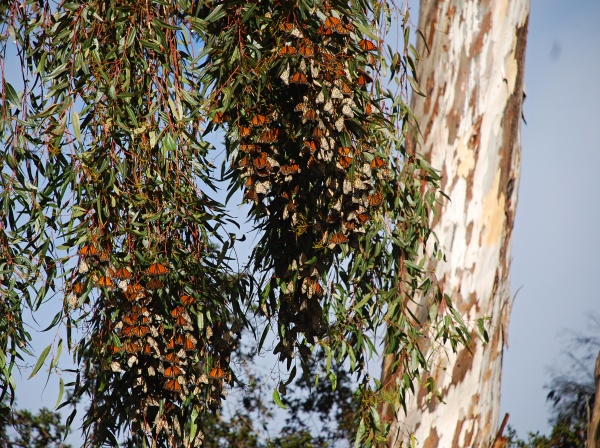Counting Monarchs in the Rain
The rain was fierce, pouring down in steady sheets on this cold morning in Ventura. What kind of day is this to count butterflies, I wondered as I pulled into a small neighborhood park to meet Donna Grubisic, a volunteer with the Vista-based Monarch Program. Fat drops fell on our heads as we shook hands underneath our umbrellas and walked passed playground equipment to a fence overlooking a grove of eucalyptus trees.
“Do you see ‘em?” she asked pointing to a low hanging branch.
“Uh…”
“Right there.”
OOOOHhhh…that low hanging branch was not covered with leaves…but rather was filled with butterflies, monarchs with dull under-sided folded wings. Huddled together motionless, the clump of monarchs were finding strength, protection and warmth in numbers.
An average monarch weighs about 500 milligrams and large raindrops have a mass of 70 milligrams or more. Michael Raupp, professor of entomology at the University of Maryland compares raindrops splashing on monarchs to humans “being pelted by water balloons with twice the mass of bowling balls.” Ouch.
Grubisic demonstrated how she counts this particular butterfly grouping – she uses both 2D and 3D estimates then adds for those hidden flappers that are inside of the monarch mass. “It’s about 750-800 butterflies,” she says about this particular clump. “Give or take.”
This location is one of seven that Grubisic has overseen for this year’s annual Western Monarch Thanksgiving Count which has been around since 1997. Taking its cue from Audubon’s Christmas Bird Count and the North American Butterfly Association’s Fourth of July Butterfly Count, the monarch tally is a way for citizen scientists to measure the health of the country’s most beloved winged insect that overwinters in the (usually) warm climates of SoCal and Baja. (Not today!)
The count starts in late November since that’s traditionally when most monarchs in the West convene along Pacific coastlines in individual trees or in huge groves. There are about 200 sites in California but only 100 are counted (not enough volunteers. Contact the Western Monarch Thanksgiving Countto learn how you can help). Monarchs typically hang out in our turf until early spring when they mate, lay eggs and then…die. Only 3 percent of the monarchs eggs will make it to butterfly-hood and they will carry on the age-old migration pattern.
Grubisic counts at locations in Ventura, Carpentaria and Summerland and her numbers will be added to the ongoing tally sponsored by the Xerces Society in Oregon. (The official numbers from this count will be released in early spring.) She’ll not only count, but make notes about roosting trees, eroding habitats, any new development in the area and other new butterfly behavior.
In addition to counting butterflies, Grubisic is a docent at Ellwood Butterfly Grove in Goleta, where, among the sprawling eucalyptus trees, she welcomes visitors, answers questions and learn about butterflies in the ecosystem.
So far, the count at Ellwood has been down, she says. “It was 17,000 last year and as of about [mid-November] only 2,000” she explains. Monarch Program intern Charis van der Heide at Ellwood concurs in an email saying that “this year is shaping up to be very intriguing.” While the monarch numbers are indeed low for Ellwood (last year there was a peak of 40,000 in December), up further north folks are seeing record numbers at Pismo Beach Monarch Grove. More than 34,000 were counted very early in the season.
“The butterflies seem to be shaking things up this year,” van der Heide concludes. “It will be really interesting to see what the numbers look like throughout California.” Climate change theories anyone?
Overall, should California count its blessings when it comes to the western monarchs? A recent article by Jim Robbins in The New York Times “The Year the Monarch Didn’t Appear” describes the incredibly low numbers of monarchs that made it to Michoacan, Mexico this year. As of mid-November, only 3 million had arrived at their wintering home – last year it was 60 million and even that was a pretty low historical number.
Grubisic notes that her counting areas have either yielded more, less or the same numbers of flutters. “Maybe they are roosting in other areas we just don’t know about,” she offers as we tour another one of her locations. The rain is letting up and it’s easier to see the hanging clumps of butterflies high above. They look so vulnerable, clinging to one another, braving the wet and cold, waiting for the sun and spring flowers.
Every year, more of their habitat is destroyed along with their beloved milkweed, the only plant they will lay their eggs on. According to the Loose Leaf blog of the American Forest Association, “the world’s monarch butterflies now fit into an area smaller than four football fields.” It’s the smallest space in 20 years.
With a background in ornamental horticulture, Grubisic became interested in butterflies when her kids were little. As a family, they raised caterpillars, watching the transformation and later tagging the flappers to see how far they would travel. Slowly, Grubisic added nectar flowers into her garden which today, she says, is overflowing with ceanothus, lantana, star dusters and of course, dozens of varieties of milkweed.
When you plant milkweed for the butterflies, she says, expect to find sticks in the spring from all those hungry caterpillars. “People who want pretty gardens need to know that if they plant milkweed,” she says. “But the plant comes back.” (See where to purchase milkweed in SoCal.)
After touring Grubisic’s sites, we are back at the first location. As if on cue, the sun comes out and the butterflies start moving, stretching and even leaving their clusters. A man and his dog come to the playground and he stops to watch the monarchs. He tells us that as a kid his class would visit this spot regularly during the migration and he remembers one year the trees “were orange. So many butterflies. You couldn’t even see the trees.”




